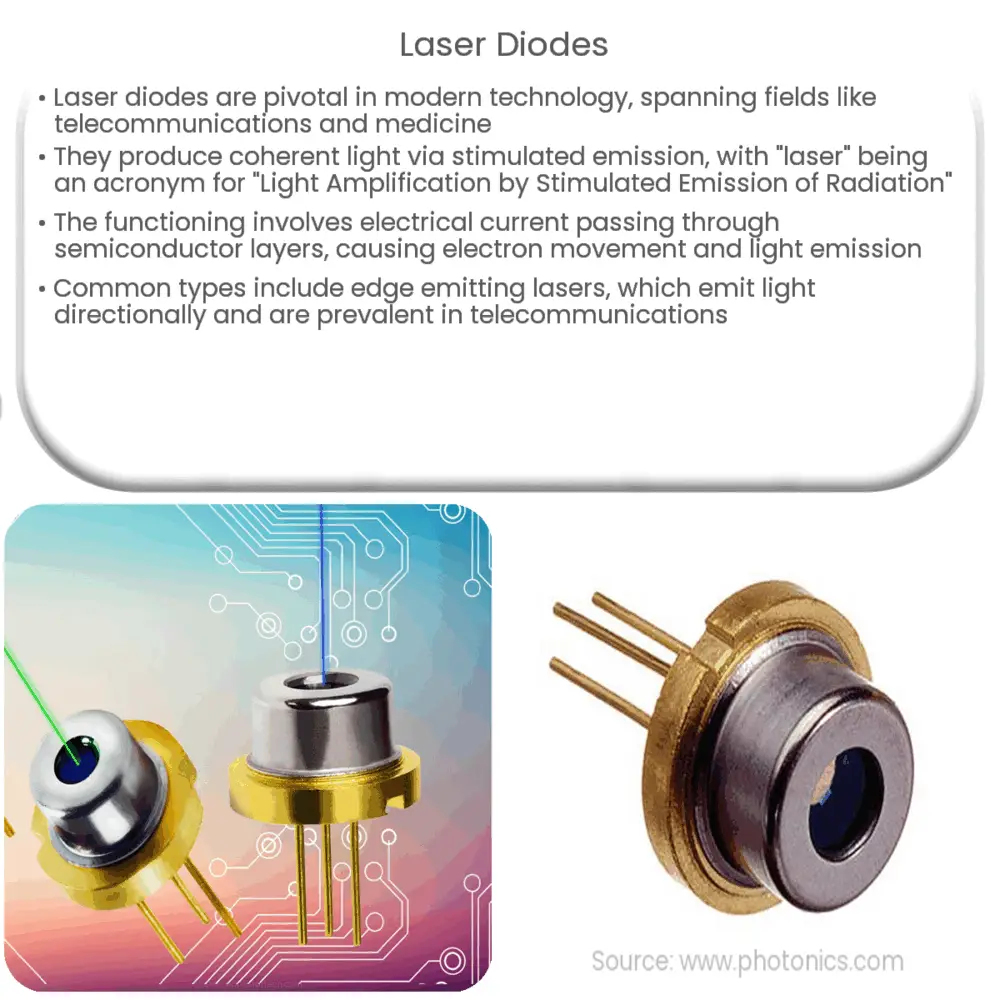Explore the intricate world of laser diodes. Understand their functioning, types, uses in modern technology, and future prospects.

Laser Diodes: Unveiling The Light of Modern Technology
Laser diodes are fundamental components in modern technology, especially in the fields of telecommunications, medicine, and entertainment. But what exactly are they, and how do they work? This article will delve into the fascinating world of laser diodes, exploring their functionality, uses, and the science behind them.
Understanding Laser Diodes
Laser diodes are devices that produce coherent light through the process of stimulated emission. The term “laser” is actually an acronym, standing for Light Amplification by Stimulated Emission of Radiation. In simpler terms, a laser is a device that emits light through a process of optical amplification based on the stimulated emission of electromagnetic radiation.
How Does a Laser Diode Work?
A laser diode operates through a complex interaction between electricity and light. These components are typically made from layers of semiconductor material. When a current is passed through the diode, it excites the electrons within the semiconductor, causing them to move from a lower energy level to a higher one. When the electrons return to their original energy state, they emit photons, particles of light. This process is known as electroluminescence.
- Active Region: The layer of the semiconductor where the electron movement and subsequent photon emission occur is called the active region. The photons created in this area are then confined and amplified to create a beam of coherent light.
- P-N Junction: The actual area where the electrical current is injected, termed the p-n junction, is crucial in the laser diode’s operation. The p-n junction is formed at the interface between the two types of semiconductor material, known as p-type and n-type, which are positive and negative, respectively.
Types of Laser Diodes
Laser diodes come in a variety of types, each with its own set of characteristics and applications. Two of the most common types are edge emitting lasers and vertical cavity surface emitting lasers (VCSELs).
Edge Emitting Lasers: In these lasers, the light is emitted from the edge of the semiconductor. Edge emitters are used extensively in telecommunications and data communications due to their ability to emit a highly directional beam of light.
Vertical Cavity Surface Emitting Lasers (VCSELs): VCSELs, on the other hand, emit light perpendicular to the surface of the chip rather than from its edge. This unique characteristic allows them to be easily integrated into arrays, making them particularly useful in applications like fiber optic communications, sensor technology, and laser printers.
Applications of Laser Diodes
Laser diodes play a pivotal role in numerous modern technologies. Let’s take a look at a few key applications:
- Telecommunications: Laser diodes are essential in fiber optic communication systems. They convert electrical signals into light, allowing for rapid and reliable data transmission over long distances.
- Medicine: In the medical field, laser diodes are used in a variety of procedures, including laser surgery, medical imaging, and therapeutic treatments.
- Entertainment: Laser diodes are commonly found in entertainment devices like DVD and Blu-ray players, where they read data from the disc. They’re also used in laser light shows.
The Future of Laser Diodes
The future looks bright for laser diodes, with researchers continually striving to improve their efficiency and versatility. With the advent of high-power, high-efficiency diodes, we can expect to see them playing even larger roles in industries like renewable energy, where they can be used in applications such as solar panel optimization. Furthermore, developments in nanotechnology could lead to even smaller and more efficient laser diodes, opening up new possibilities in fields like computing and telecommunications.
Conclusion
In conclusion, laser diodes are small yet incredibly powerful devices that have fundamentally reshaped our world. Their unique ability to convert electrical energy into light has found applications in a diverse range of fields, from telecommunications to medicine and entertainment. As technology continues to advance, we can expect to see laser diodes playing an increasingly important role, shining a light on the path to our future.

